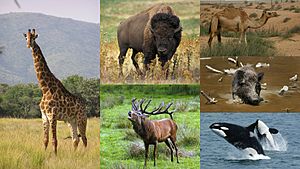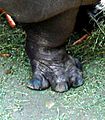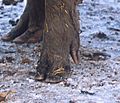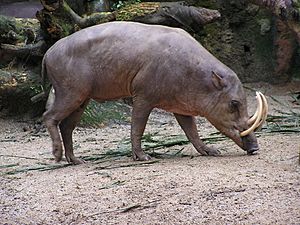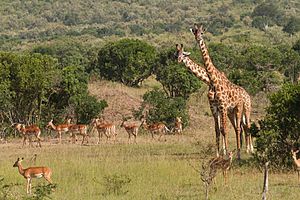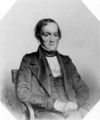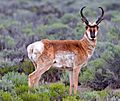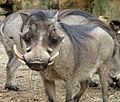Artiodactyl facts for kids
Quick facts for kids Even-toed ungulatesTemporal range: Lower Eocene
|
|
|---|---|
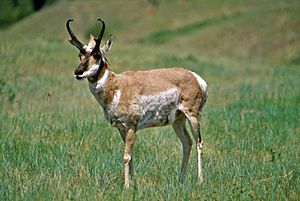 |
|
| Pronghorn (Antilocapra americana) | |
| Scientific classification | |
| Kingdom: | |
| Phylum: | |
| Class: | |
| Infraclass: | |
| Superorder: | |
| Order: |
Artiodactyla
Owen, 1848
|
| Suborders | |
The even-toed ungulates are a group of mammals. They belong to the order called Artiodactyla.
These animals are special because they have an even number of toes on each foot. This means they have either two or four toes. For example, camels and giraffes have two toes. But hippos have four toes.
This group includes about 220 different kinds of animals. Some well-known even-toed ungulates are pigs, hippopotamuses, camels, llamas, deer, giraffes, antelopes, sheep, goats, and cattle. Many of these animals are very important to humans for food, work, and culture.
Contents
What are Even-Toed Ungulates?
Even-toed ungulates are a large group of mammals. They are known for having an even number of toes. This is different from "odd-toed" animals like horses.
Scientists group these animals into different families. Here are some of the main groups:
- Artiodactyla (the main order)
- Suborder Suina (includes pigs and hippos)
- Family Suidae (Pigs)
- Family Tayassuidae (Peccaries)
- Family Hippopotamidae (Hippos)
- Suborder Tylopoda (includes camels)
- Family Camelidae (Camels)
- Suborder Ruminantia (includes animals that chew their cud)
- Family Tragulidae (Mouse deer)
- Family Moschidae (Musk deer)
- Family Cervidae (Deer)
- Family Giraffidae (Giraffes and Okapis)
- Family Antilocapridae (Pronghorns)
- Family Bovidae (Cattle, goats, sheep, and antelopes)
- Suborder Suina (includes pigs and hippos)
How are Even-Toed Ungulates Built?
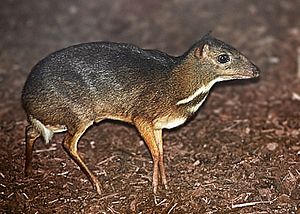
Most even-toed ungulates walk on four legs. They come in many shapes and sizes. Some, like pigs and hippos, have strong, stocky bodies. They also have short legs and large heads. Others, like camels and deer, are more slender. They have long, thin legs.
The smallest even-toed ungulate is the mouse deer. It is only about 45 centimeters (18 inches) long. It weighs around 1.5 kilograms (3.3 pounds). The largest is the hippopotamus. It can be up to 5 meters (16 feet) long. It can weigh 4.5 metric tons (9,900 pounds). Giraffes are the tallest, reaching 5.5 meters (18 feet) high.
Males are usually bigger and heavier than females. In deer, only the males have antlers. Female bovines (like cows) often have smaller horns or no horns at all.
Most even-toed ungulates have fur. The color and length of their fur depend on where they live. Animals in colder places might shed their fur in warmer seasons. Their fur often helps them blend in with their surroundings.
Their Legs and Feet
Even-toed ungulates get their name from their even number of toes. They usually have two or four toes. The main part of their leg is between the third and fourth toe. The first toe is missing in modern animals.
The second and fifth toes can be different. In hippos, they point forward and are used for walking. In pigs and deer, these toes point backward. They can touch soft ground, helping the animal not sink. In some animals, like camels and giraffes, these toes are completely gone.
Camels have only two toes. Their claws have changed into nails. Claws are curved and pointed, while nails are flat. Most even-toed ungulates walk on the tips of their toes.
Their leg bones are long and slender. This helps them run fast. They do not have a clavicle (collarbone). Their shoulder blade is very flexible. This also helps them move quickly. Their legs cannot rotate, which makes them very stable when running.
Their Heads
Many even-toed ungulates have a large head. Their skull is long and narrow. The front part of the skull is often very big.
Horns and Antlers
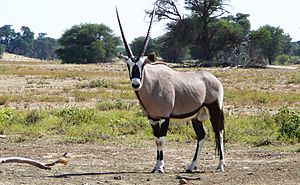
Many even-toed ungulates have special growths on their heads. These are called cranial appendages. There are four main types:
- True horns are found on bovids (like cattle and goats). They have a bone core covered by a hard, permanent layer of keratin. Keratin is the same material as your fingernails.
- Antlers are found on deer. They are made of bone and are shed (fall off) and regrow each year. Antlers can be branched, like on a White-tailed deer, or flat, like on a Moose.
- Ossicones are permanent bone growths. They are found only on giraffes.
- Pronghorns are similar to horns but are shed each year. They are found only on the pronghorn animal.
These head growths help animals show off, fight for mates, and defend themselves. Usually, only the males have them.
Teeth
Even-toed ungulates have different kinds of teeth. Pigs and hippos have many teeth, sometimes up to 44. Their teeth are good for crushing food. They are omnivores, meaning they eat both plants and meat.
Camels and ruminants (like deer and cows) have fewer teeth. They often have a gap between their front teeth and back teeth. This gap is called a diastema. Their back teeth are good for grinding plants.
Ruminants often have no upper front teeth. The canine teeth of pigs can grow into large tusks. These tusks are used for digging and defense. In some ruminants, like mouse deer, the males have long upper canine teeth used as weapons.
Senses
Even-toed ungulates have a great sense of smell. They also have very good hearing. However, their eyesight is not as strong as their other senses. They see moving things much better than still objects. Like many prey animals, their eyes are on the sides of their heads. This gives them a wide view to spot danger.
How They Live
Where They Live
Even-toed ungulates live almost everywhere in the world. They are not found in Oceania (like Australia) or Antarctica naturally. But humans have brought some of them to new places.
They can live in many different environments. This includes rain forests, steppes (grassy plains), deserts, and high mountains. They are most common in open areas like grasslands and open forests.
Social Behavior
The way even-toed ungulates live together varies. Some live alone or in pairs. But many tend to live in larger groups.
Groups often have a social order. This means some animals are more dominant than others. Some species live in "harem" groups. These have one male, several females, and their young. In other species, females and young stay together. Males might live alone or in separate groups. They only join females during mating season.
Many even-toed ungulates mark their territory. They might use scents from glands or urine. Some animals stay in one place all year. Others migrate (travel) to different areas depending on the season.
Some are active during the day. Others are active at dawn and dusk, or at night. Their activity patterns can change with the seasons or where they live.
Reproduction and Life Expectancy
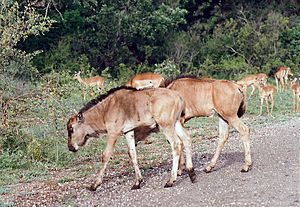
Even-toed ungulates usually have long pregnancy periods. They tend to have fewer babies at a time. Their newborns are often quite developed at birth.
In cooler places, they have a specific mating season. In tropical areas, they can breed all year.
Pregnancy times vary a lot. Pigs, deer, and musk deer are pregnant for 4 to 5 months. Hippos and cattle are pregnant for 6 to 10 months. Camels are pregnant for 10 to 13 months. Giraffes have the longest pregnancy, lasting 14 to 15 months. Most give birth to one or two babies. Some pigs can have up to ten babies at once.
Newborns are usually born with open eyes and hair. Hippo babies are an exception, as they are born without much hair. Young deer and pigs often have stripes or spots. These patterns fade as they get older. Some babies stay hidden with their mothers for a few weeks. Others can run and follow the herd within hours or days of birth.
Most even-toed ungulates live for 20 to 30 years. Smaller species often have shorter lives. Hippos, cows, and camels can live the longest, sometimes 40 to 50 years.
Predators
Even-toed ungulates have different natural predators. This depends on their size and where they live. Large meat-eating animals often hunt them. These include big cats (like lions) and bears. Other predators are crocodiles and wolves. Large birds of prey and big snakes might hunt smaller species or young animals.
Even-Toed Ungulates and Humans
Domestication
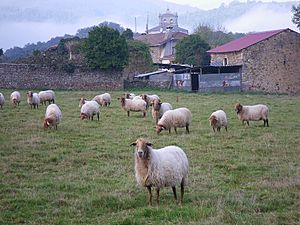
Early humans hunted even-toed ungulates for food and fur. They also used their bones, teeth, and horns for tools and weapons. People started to tame these animals around 8000 BCE.
Today, many even-toed ungulates are domesticated. These include goats, sheep, cattle, camels, llamas, alpacas, and pigs. At first, people mainly kept them for food. Later, around 3000 BCE, they started using them for work.
Ancient humans relied on these animals. For example, Cro-Magnon people heavily hunted reindeer. They used reindeer for food, skins, tools, and weapons.
Today, domesticated even-toed ungulates are still important. We keep them for meat, milk, and wool or leather for clothing. Animals like cattle, water buffalo, yak, and camels are also used for work, riding, or as pack animals.
See Also
Images for kids
-
Richard Owen coined the term "even-toed ungulate".
-
The mesonychids were long considered ancestors of whales.
-
Camels are now considered a sister group of Artiofabula.
-
The pronghorn is the only extant antilocaprid.
-
Reconstruction of Indohyus
-
Blue duiker (Philantomba monticola) skeleton on display at the Museum of Osteology.
-
The Japanese serow has glands in the eyes that are clearly visible.
-
The aurochs has been extinct since the 17th century.
See also
 In Spanish: Artiodáctilos para niños
In Spanish: Artiodáctilos para niños


